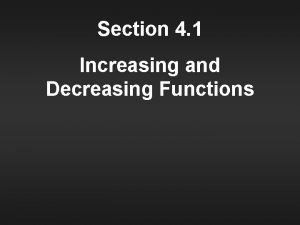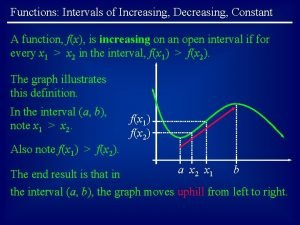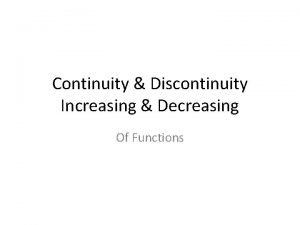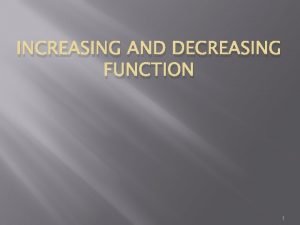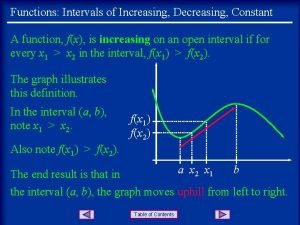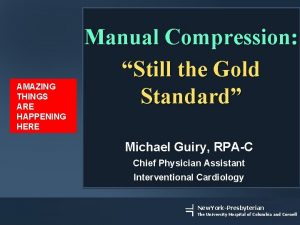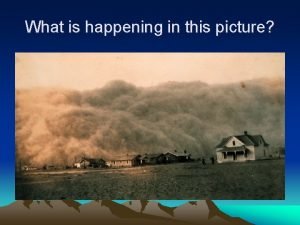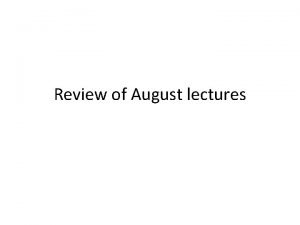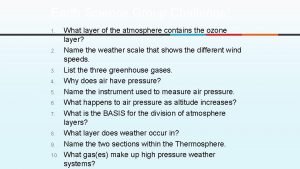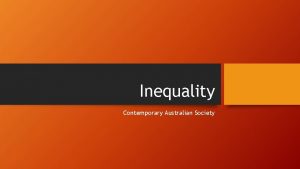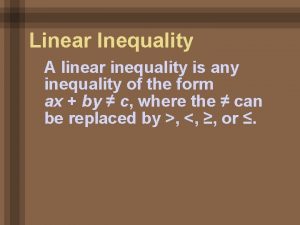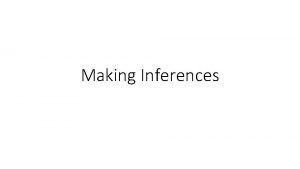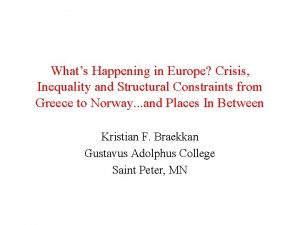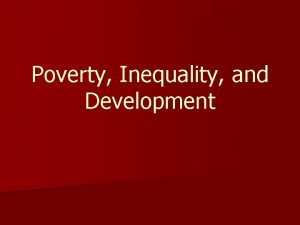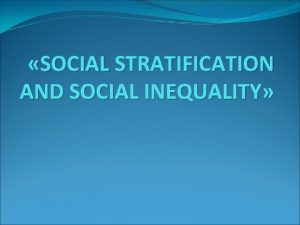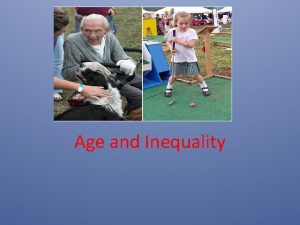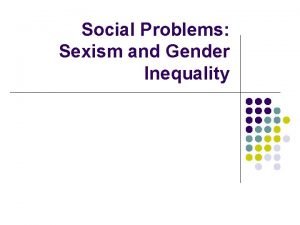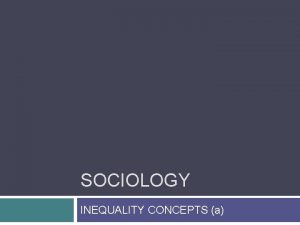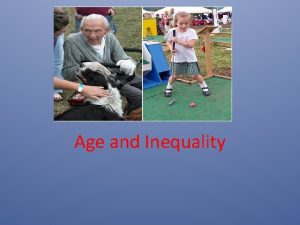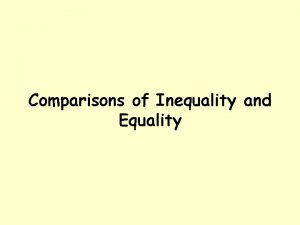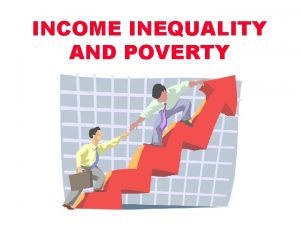Increasing Inequality Its happening it matters and we






































- Slides: 38

Increasing Inequality: It’s happening, it matters, and we can do something about it. Jared Bernstein (bernstein@cbpp. org) Ben Spielberg (bspielberg@cbpp. org) The Center on Budget and Policy Priorities Updated: 1/6/2015

Inequality… • …has risen sharply since the late 1970 s. • …reduces opportunities, undermines the democratic process, distributes growth unevenly, and may even have negative macroeconomic effects. • …is a problem we can combat with the right policy solutions.

Inequality… • …has risen sharply since the late 1970 s. • …reduces opportunities, undermines the democratic process, distributes growth unevenly, and may even have negative macroeconomic effects. • …is a problem we can combat with the right policy solutions.

Earnings Inequality Social Security Administration data 1947 1979 2012 Top 1%: $131, 072 $255, 760 $648, 541 Bottom 90%: $14, 392 $27, 110 $31, 741 Ratio: 9. 1 9. 4 20. 4 Source: Wage data, tab 3

Earnings Inequality Bureau of Economic Analysis: National Income and Product Accounts data Source: Table 1. 12

Income Inequality Census data Source: Tables F-1 and F-5

Income Inequality Congressional Budget Office data Source: Calculations from Supplemental Data

Income Inequality Congressional Budget Office data Source: Calculations from Supplemental Data

Income Inequality Internal Revenue Service tax data Source: “Piketty and Saez”

Wealth Inequality Survey of Consumer Finances data Source: Federal Reserve Bulletin

Wealth Inequality Internal Revenue Service tax data and Federal Reserve Flow of Funds data Source: “Wealth Inequality in the United States since 1913: Evidence from Capitalized Income Tax Data ”

Inequality… • …has risen sharply since the late 1970 s. • …reduces opportunities, undermines the democratic process, distributes growth unevenly, and may even have negative macroeconomic effects. • …is a problem we can combat with the right policy solutions.

Inequality… • …has risen sharply since the late 1970 s. • …reduces opportunities, undermines the democratic process, distributes growth unevenly, and may even have negative macroeconomic effects. • …is a problem we can combat with the right policy solutions.

1. Inequality may have negative macroeconomic effects. Mechanisms: A. Different spending propensities B. The bubble/bust syndrome Evidence:

1. Inequality may have negative macroeconomic effects.

1. Inequality may have negative macroeconomic effects. Mechanisms: A. Different spending propensities B. The bubble/bust syndrome Evidence: • Cynamon and Fazzari • Kumhof and Ranciére • Mian and Sufi

2. Inequality matters because it creates a “wedge, ” channeling growth away from the typical worker. Mechanisms: A. Globalization B. Technological change C. Decreased worker bargaining power D. The tax code, financial deregulation, and corporate compensation Evidence: Source: Economic Policy Institute

2. Inequality matters because it creates a “wedge, ” channeling growth away from the typical worker. Mechanisms: A. Globalization B. Technological change C. Decreased worker bargaining power D. The tax code, financial deregulation, and corporate compensation Evidence: • Bernstein • Danziger • Mishel, Bivens, Gould, and Shierholtz • Saez

3. Inequality matters because it undermines the democratic process. Mechanism: Evidence: The influence of money in politics makes the political system more responsive to the wealthy and less responsive to everyone else Source: Gilens and Page

3. Inequality matters because it undermines the democratic process. Mechanism: Evidence: The influence of money in politics makes the political system more responsive to the wealthy and less responsive to everyone else Source: Gilens and Page

3. Inequality matters because it undermines the democratic process. Mechanism: The influence of money in politics makes the political system more responsive to the wealthy and less responsive to everyone else Evidence: • Bartels • Bernstein • Gilens

4. Inequality matters because it reduces opportunities for millions of Americans. Mechanisms: Evidence: A. Residential segregation by income B. Educational investment barriers C. Direct effects Source: Reardon presentation at the Boston Federal Reserve, October 17 -18, 2014

4. Inequality matters because it reduces opportunities for millions of Americans. Mechanisms: Evidence: A. Residential segregation by income B. Educational investment barriers C. Direct effects Source: Yellen

4. Inequality matters because it reduces opportunities for millions of Americans. Mechanisms: Evidence: A. Residential segregation by income B. Educational investment barriers C. Direct effects Source: Duncan and Murnane

4. Inequality matters because it reduces opportunities for millions of Americans. Mechanisms: Evidence: A. Residential segregation by income B. Educational investment barriers C. Direct effects Source: Bradbury and Triest

4. Inequality matters because it reduces opportunities for millions of Americans. Mechanisms: Evidence: A. Residential segregation by income B. Educational investment barriers C. Direct effects Source: Pew Economic Mobility Project

4. Inequality matters because it reduces opportunities for millions of Americans. Mechanisms: Evidence: A. Residential segregation by income B. Educational investment barriers C. Direct effects Source: Sherman, Parrott, and Trisi

4. Inequality matters because it reduces opportunities for millions of Americans. Mechanisms: A. Residential segregation by income B. Educational investment barriers C. Direct effects Evidence: • Bradbury and Triest • Chetty, Hendren, Kline, and Saez • Pew Economic Mobility Project • Reeves and Sawhill • Sard and Rice

Inequality… • …has risen sharply since the late 1970 s. • …reduces opportunities, undermines the democratic process, distributes growth unevenly, and may even have negative macroeconomic effects. • …is a problem we can combat with the right policy solutions.

Inequality… • …has risen sharply since the late 1970 s. • …reduces opportunities, undermines the democratic process, distributes growth unevenly, and may even have negative macroeconomic effects. • …is a problem we can combat with the right policy solutions.

Inequality is a problem we can combat with the right policy solutions. • Full employment Source: Baker and Bernstein

Inequality is a problem we can combat with the right policy solutions. • Full employment • Collective bargaining Source: Furman

Inequality is a problem we can combat with the right policy solutions. • Full employment • Collective bargaining • Other labor standards Source: Gould

Inequality is a problem we can combat with the right policy solutions. • Full employment • Collective bargaining • Other labor standards • Access to quality education Source: Smeeding

Inequality is a problem we can combat with the right policy solutions. • Full employment • Collective bargaining • Other labor standards • Access to quality education • Regulation and Improved Fiscal Policy Source: CBPP

Inequality is a problem we can combat with the right policy solutions. • Full employment • Collective bargaining • Other labor standards • Access to quality education • Regulation and Improved Fiscal Policy • Safety Net Programs Source: CBO

Inequality… • …has risen sharply since the late 1970 s. • …reduces opportunities, undermines the democratic process, distributes growth unevenly, and may even have negative macroeconomic effects. • …is a problem we can combat with the right policy solutions.

Thank You! Jared Bernstein (bernstein@cbpp. org) Ben Spielberg (bspielberg@cbpp. org) The Center on Budget and Policy Priorities
 Write a compound inequality as an absolute value inequality
Write a compound inequality as an absolute value inequality Classify each decreasing function as having a slope
Classify each decreasing function as having a slope Ordinary language means
Ordinary language means The emigree and london comparison
The emigree and london comparison Its halloween its halloween the moon is full and bright
Its halloween its halloween the moon is full and bright How to find increasing and decreasing intervals on a graph
How to find increasing and decreasing intervals on a graph Function of a constant
Function of a constant Removable and nonremovable discontinuity
Removable and nonremovable discontinuity Britain diamond mining and increasing labour control
Britain diamond mining and increasing labour control Lesson 4 increasing and decreasing functions
Lesson 4 increasing and decreasing functions Lesson 5 increasing and decreasing functions
Lesson 5 increasing and decreasing functions Strictly increasing and decreasing functions
Strictly increasing and decreasing functions Increasing intervals
Increasing intervals Piecewise function increasing decreasing
Piecewise function increasing decreasing Increasing and decreasing recipes
Increasing and decreasing recipes Interval of increase parabola
Interval of increase parabola Orange shirt day quotes
Orange shirt day quotes When a train increases its velocity its momentum
When a train increases its velocity its momentum Sunny cloudy rainy snowy windy
Sunny cloudy rainy snowy windy If its square its a sonnet summary
If its square its a sonnet summary Its not easy but its worth it
Its not easy but its worth it Good hazard scenarios describe where it is happening
Good hazard scenarios describe where it is happening Swiss snow happening 2023
Swiss snow happening 2023 Happening umjetnost
Happening umjetnost Performance happening
Performance happening Global warming is not happening
Global warming is not happening What is happening in this picture
What is happening in this picture Amazing things are happening here
Amazing things are happening here Waning crescent
Waning crescent What is this image
What is this image What do you think is happening in this picture?
What do you think is happening in this picture? What is happening ___ this picture
What is happening ___ this picture Picture with lots of things happening
Picture with lots of things happening Teatr eksperymentalny
Teatr eksperymentalny Happening art
Happening art What is happening in the picture
What is happening in the picture Who was she? where was she? what was happening?
Who was she? where was she? what was happening? Whats happening in this photo
Whats happening in this photo What's happening in the picture
What's happening in the picture

